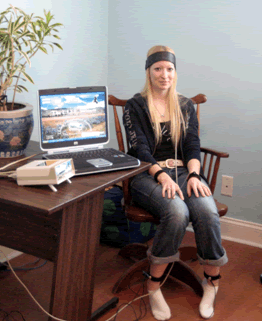


Cable & Box Connections
Attach the USB interface cable, the 9-pin head harness cable and the 9-pin limb harness cable to the back of the I.M.A.E.T. System box. Attach the other end of the USB interface cable to the back of your computer, ONLY AFTER THE SOFTWARE HAS BEEN INSTALLED, OR YOU ARE INSTRUCTED TO DO SO DURING THE SOFTWARE INSTALLATION PROCESS.
Limb Harness Placement
The 4 limb harness bands may be
applied to ANY wrist or ankle.
Head Harness Placement
Wrap snugly around head, with the 8 conductive vinyl strips in contact with the
forehead. Secure at the back of the head with Velcro enclosure.
Quick-Start Summary
A typical combined assessment and feedback procedure should last approximately
1 hour, dependent upon: 1: the client interview, 2: type of information provided by the client, 3: the Body-Biofield Reactivity assessment, and 4: subsequent feedback procedures.
The following typical protocol is suggested:
Step 1: Open the program and click Continue upon opening the initial panel. This will bring you to the Navigation page. Next, type your password into the Login field. Then click To Demographics on the Navigation panel. Click New Client then Enter Name, Address, Phone number etc. and any other appropriate information you may wish to enter about your client. Click Save All before leaving.
Step 2: Proceed to the Lifestyle Profile, and enter the client’s numerical responses, based upon each of the 20 questions posed. Do not enter percentages or letters, only numbers.
Step 3: Proceed to the History Profile by recording, checking and entering information into all appropriate fields. Now return to Lifestyle Profile.
Step 4: Attach the head harness and the wrist & ankle straps to the client. Then click Calibration. Upon completion, click save and proceed to step 5.
Step 5: Click To Body-Biofield Test to initiate activation of the assessment process. This test is used to evaluate responses relevant to possible indications of stress and muscle tension. Click the “Test Potential” button to begin the process.Following an approximate 4 to 7 minute test, the most significant results and indications for relaxation feedback will be displayed in descending numerical order from top to bottom. A bar graph is also used to graphically display a significant response. These results may then be used as a guide for considering subsequent feedback procedures. A response of 75% or greater (on the graph), or 1500+ (in the numerical,“Significance” column), is considered appropriate for applying a feedback procedure. You may then select any item in the matrix by clicking and highlighting it and then clicking either the 5 Second Auto or Feedback–30 Seconds button. An additional option would be to set the timer for the desired feedback duration, 1 to 30 minutes, then select either the Harness or Metaspace option.
Note: In order to go directly to the NAET panel, please skip test potential and go directly to Wellness Info!
It is not recommended to do a Body-Biofield assessment and a NAET reactivity assessment on the same day / visit. Please do either / or and work with the information obtained!!
Step 6: When you have completed all desired functions, proceed to the Wellness Info panel. Click on the red Wellness Info button, and select one of the 16 programs offered there. Depending on the information in the main reactivity test or your judgment, choose one of those programs.
It is on the Wellness Info page where you will find the NAET page, which will take you to the NAET Profile.
Step 7: Based upon the information provided by all of the previous factors, the practitioner will go to Wellness Info to choose and apply the specific feedback procedures as indicated. Typical feedback procedures range one to three minutes, or more, dependent upon individual assessment needs.
Step 8: Upon completion of feedback, results may be assessed through a brief, final interview with the client, to determine his/her sense of wellness and relaxation/stress reduction levels. Subsequent visits may be determined and scheduled in accord with the client’s personal and/or projected sense of well-being, as well as the practitioner’s observation.
